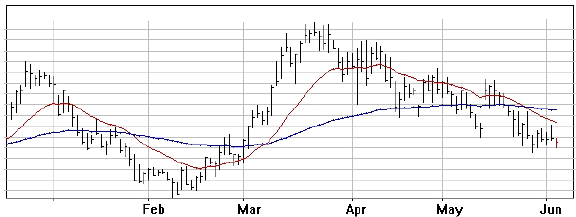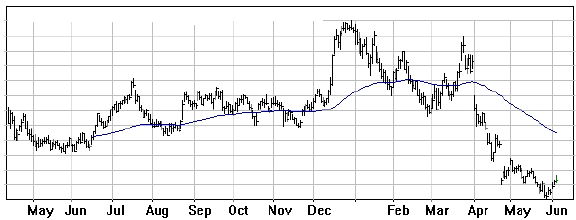
The Moving Average (MA) is one of
the simplest, yet most versatile and widely used of all technical indicators.
The MA attempts to tone down the fluctuations of market prices to a smoothed
trend, so that distortions are reduced to a minimum. MAs help in tracking trends
and signalling reversals. You could think of the MA as a curved trendline,
fitting itself to the market.

Signals to buy or sell are generated when the price crosses the MA or when one MA crosses another, in the case of multiple MAs. As with trendlines, the MA often provides an area of support and resistance. The more times an MA has been touched (i.e., acts as support or resistance) the greater the significance when it is crossed.
Since the MA is a lagging indicator, a crossover will usually signal a trend reversal well after a new trend has begun and is used largely for confirmation. Generally speaking, the longer the time span covered by an MA, the greater the significance of a crossover signal. For example, the crossover of a 100 or 200-day MA is significantly more important then the crossover of a 20-day MA.
Moving averages differ according to the weight assigned to the most recent data. Simple moving averages apply equal weight to all prices. Exponential and weighted averages apply more weight to recent prices. Variable moving averages change the weighting based on the volatility of prices.
When prices fluctuate up and down in a broad sideways pattern for an extended period (trading-range market), longer term MAs are slow to react to reversals in trend, and when prices move sideways in a narrow range shorter term MAs often produce false signals. Flat and conflicting MAs generally indicate a trading-range market and one to avoid, unless there is pronounced rounding that suggests a possible new trend.
|
Type of MA |
Description |
Methods Used |
|
Simple (This is the most commonly used MA) |
Use of multiple MAs can provide good signals Useful periodsShort term 10-30 day There is no perfect time span |
Crossover of short term through long term Convergence/ Divergence Crossover of MA by price |
|
Linearly Weighted |
With this MA, data is weighted
in favour of most recent observations. |
Warning of trend reversal given by change in direction of the average rather than crossover. |
|
Exponential |
An exponential (or exponentially weighted) moving average is calculated by applying a percentage of today's closing price to yesterday's moving average value. Exponential moving averages place more weight on recent prices. |
Crossover of short term through long term Convergence/ Divergence Crossover of MA by price |
|
Variable |
An automatically adjusting exponential moving average based on the volatility of the data. |
The more volatile the data, the greater the weight given to the current data and the more smoothing used in the moving average calculation. |
The variable MA is able to compensate for trading-range versus trending markets. This MA automatically adjusts the smoothing constant to adjust its sensitivity, often allowing it to outperform the other moving averages in these difficult markets.
MAs should always be used in conjunction with other indicators because of the potential for false signals (whipsawing) and, particularly during sideways channels. MAs can be calculated on a security's open, high, low, close, volume, or on any other indicator. Indicators which are especially well-suited for being used with moving averages include MACD, Price ROC, Momentum, and Stochastics. A moving average of another moving average is also common.
Moving averages are helpful in keeping you in line with the price trend by providing buy signals shortly after the market bottoms out and sell signals shortly after it tops, rather than trying to catch the exact bottom or top.
A price break upwards through an MA is generally a buy signal, and a price break downwards through an MA is generally a sell signal. As we have seen, the longer the time span or period covered by an MA, the greater the significance of a crossover signal.
If the MA is flat or has already changed direction, its violation is fairly conclusive proof that the previous trend has reversed.
False signals can be avoided by using a filtering mechanism. Many traders, for example, recommend waiting for one period - that is one day for daily data and one week for weekly data.
Whenever possible try to use a combination of signals. MA crossovers that take place at the same time as trendline violations or price pattern signals often provide strong confirmation.

It is usually advantageous to employ more than one moving average. Double and triple MAs often provide useful signals.
With two MAs the double crossover is used; a buy signal is produced when the shorter average crosses above the longer, and vice versa for the sell signal. For example, two popular combinations are the 5 and 20-day averages and the 20 and 100-day averages. The technique of using two averages together lags the market a bit more than a single moving average but produces fewer whipsaws.

The triple crossover method is also popular, using three moving averages. The most widely used triple crossover system is the popular 4-9-18-day MA combination. A buy signal is generated when the shortest (and most sensitive) average - the 4 day - crosses first the 9-day and then the 18-day averages, each crossover confirming the change in trend.
Additional Points:
Also see MACD for further use of the moving average